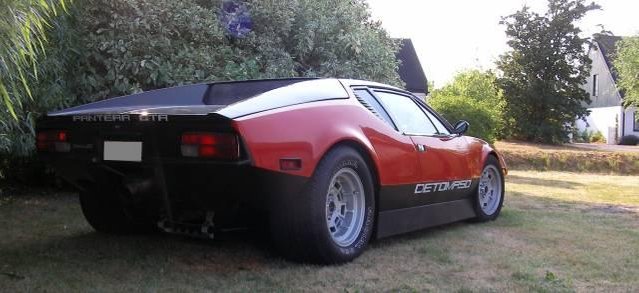It is a DeTomaso Pantera from -72, imported from California in the late
eighties and purchased by us in the winter of 2001.
The car was in almost in original condition apart from the nonstandard American rims
that can be seen on the image. The car had never been
renovated and was in good original / working order.
The weight of the rims was substantial, the rear wheels were difficult to
lift by yourself, although in the dimension 295/50 -15. So the hunt
for a set of original magnesium wheels began immediately. While there are
still new, original rims to buy the price of 15000kr per rear wheel
makes it less appealing to buy new ones.
Some renovations and upgrades were made before the summer of 2001, which among other things were changeing the master brake cylinder. This is a comon fault on Panteras.
The steering rack was renovated and the ceiling had to be replaced because it had come loos and was hanging down and held in place in one end by an icecream stick! The instrumentation panel also was missing one switch which made the car looking really worn down on the inside, so we bought a new original.
The car was used extensively during the summer with both track days at
Kinnekulle ring, street race in Norrtälje and drag racing at
Tullinge Raceway (slideshow) with a quarter mile time of 13.633 i.e. alot of grunt
in the original 351 Cleveland V8 with holly carburetor.
When the autumn came plans were drawn up to change the engine to a V8 BMW
(M60B40) plus several other modification to the car which was put on
jack stands and disassembled.
The car was suppose to be ready by spring 2002 but like almost all projects the deadline was exceeded a bit. It took until the summer of 2005 before the Pantera was back
on the road again.
In the slideshow is a picture of the car in its
present state.
The car was taken apart and thoroughly inspected.
The hole frame was checked inside with optical fibers and we concluded
that we had managed to find a well preserved example with little
rust.
It is one of the most important things to check if the car is free from
rust when buying a Pantera and a rust free car can be expensive and
hard to find. The cars chassis is in fact a monocoque comprised of
many steel sheets welded together i.e. very susceptible to rust.
The only place we found rust was in the compartment in front of the left
rear wheel. This had occurred because of a little gap between the
body and the forward facing wheel arch which allowed road dirt to
collect inside the body.
This was fixed by a very competent body work specialist who removed all
affected part and replaced it with hand fabricated steel sheet. We
modified the wheel arch so it would not happen again.
The Pantera is an interesting car in the way that it is fairly common that owners exchange engine in them. I have seen several different engine configurations in other Panteras, for example: Windsors, Chevy and Ford small and big blocks, more modern Ford 4-valve engines and even Chrysler hemis and last but not least Carapis Pantera with a big block chevy engine which won several “Swedens fastest roadcar” awards during the nineties and still holds the official "Swedish land speed record".
The engine we chose was a BMW v8 M60B40 seen in the slideshow, one
was purchased in the late nineties for another project but it did not
work out so when we acquired the Pantera in -01 the plans was drawn
up for the engine change. This engine was then later replaced by a BMW Alpina 4.6l V8 making 350Hp in stock form.
The Cleveland engine was taken apart inside the car because we did not have an engine lift that could hanlde that load at the time. The heads where removed and then the block was lifted out of the car. In picture 1 in the slideshow.
The engine we chose was a BMW V8 M60B40 (4Litre). One was purchased in the late nineties for another project but it did not work out so when we acquired the Pantera in 2001 the plans was drawn up for the exchange.
The BMW engine was at the same time being taken apart, washed and inspected.
A dissasembled V8 takes up a lot of space especially if it is a twin cam engine and since the garage is full of other "crap" it can be difficult. Like the bonnet of a Lotus Elan -64 hanging on the wall or the inline 4 cylinder engine under the bench (under the BMW head covers) from a Lotus Esprit - 81. But there is a saying...the one with the most things when he dies win...=).
In the slideshow the pistons and rods from the BMW V8 can be seen. The rods have a nice design, however, they are made by powder metallurgy, which gives lighter rods but unfortunately with lesser mechanical properties then forges units.
In picture 7 the original Cleveland heads can be seen. They are made of cast iron and weighs enormously compared with the aluminum heads of the BMW.
The second important thing to inspect when buying a Pantera is that the gearbox is in good condition and do not need rebuilding as it is very expensive. Admittedly, these gearboxes are considered "bullet prof" as when in good condition can handle four-digit torque numbers. There are still new transmissions to buy from the U.S. and also a newly developed 6-speed version, but these will set you back over 100K (Sek) in the standard version and a lot more for the 6-speed. ZF gearbox was originally designed to be used in the Ford GT40 in both street and race versions. And these cars as many people know, won the Le Mans several times during the 60:ies. An enhanced version of the gearbox even used in the BMW M1.
THe gearbox was cleaned and inspected and seemed to be in good order. THe only things we did was to paint the side steel plates and change some gaskets.
Pantera Gearbox
Engine/Gearbox mating
The engine Change
The beginning of the Project
The first season
An alu plate was clamped to the ZF and centered on the input shaft and the mounting holes was drilled out. Tip machinde screwes was inserted in the engine monting holes. The plate was then centerad on the crankshaft on the engine and after a few hits with a rubber mallet...the entire block bolt circle was now marked on the plate.
The engine bolt circle was then drilled and the engine block and transmission was test assembled.
Headers and exhaust
New headers and exhaust was fabricated from strait and j-bend mandrel steel pipes.
The pipes was cut and test fitted with the engine in the car. the engine was then taken out of the car and the headers was completely welded together using oxygen/acetylene welder.
Then work began on the exhaust system. The only thing that was not fabricated by me was the 4" strait thru design muffler. Everything was sanded and painted with high temp paint.
In the picures the engine installation can be seen with three different intakes we have used over the years.
MOVIES
Brake system
The brake system was updated for better performance and lower weight.
For the front brake discs we chose 310mm stagerde vane rotors 32mm thick with alu hats and wilwood 4pot alu calipers to be able to still use the standard 15" magnesium wheels.
For the rear 300mm straight van rotors 19mm thick was chosen with the same type of calipers as on the front.
We also upgraded to aluminum front hubs for weight and rotor instalation reasons.
A new aluminum master cylinder was used to replace the old steel unit that has an unusual sealing arangment for the pistons that can be hard to restore if worn out.
New Half shafts
The half shafts was replaced to more modern ones with CV-joints. Partly because the new ones are maintenance free plus the old ones was spitting out grease when going fast =)
First season with the BMW engine
This is what the car looked like the first season with the BMW V8 engine. I had been able to find a set of original Pantera campagnolo magnesium wheels to replace the chrome spoke wheels the car had when I bought it. The V8 was a M60B40 engine with original engine management system. With this setup the car made 0-100km/h in 4.6 seconds =). The seats was also replaced with a pair of seats from a Lotus Elise S1.
0-100km/h in 4.6s with 4.0l engine and standard management system
Total Weight:
1160kg (2560lbs)
-Plastic Fuel cell
Engine:
BMW Alpina V8
Displacement: 4.6l
Material: All aluminum with Magnesium valve covers
Heads: Reshaped combustion chambers, inlet and exhaust ducts.
Engine-management: DTA S8 engine management system (fully sequential ignition and injection system on 8 cyl). -One broadband lambda sensor per cylinder bank.
-Anti spin with wet and dry settings (4 wheel speed sensors)
-Launch control
Intake: 8 lightweight throttle bodies from a BMW M5 V8
Exhaust system:
Custom exhaust including headers (my own design and fabrication)
Drivetrain:
-aluminum race clutch (made by the same company who introduced carbon clutches in formula 1)
-steel driveshafts with CV-joints
-original ZF-transmission
Suspention:
Shocks: Original Pantera
Springs: Gr4 (2" lower)
Sway bars: 1" hollow
Front hubs: Aluminum
Wheels:
Front: Original 8x15" Magnesium
Rear: Original 10x15" Magnesium
Cooling system:
All aluminum with fluidyne radiator
Bodywork:
-Custom fabricated head lights (my design and my fathers fabrication)
-GT5 front spoiler and custom fabricated side spoilers (my design and my fathers fabrication)
-front and rear carbon fiber-hoods
Breaks:
Front: 310mm directional vane rotors with aluminum race calipers (4-piston)
Rear: Original rotors with aluminum race calipers (4-piston)
© Copyright 2019. All Rights Reserved.

























































